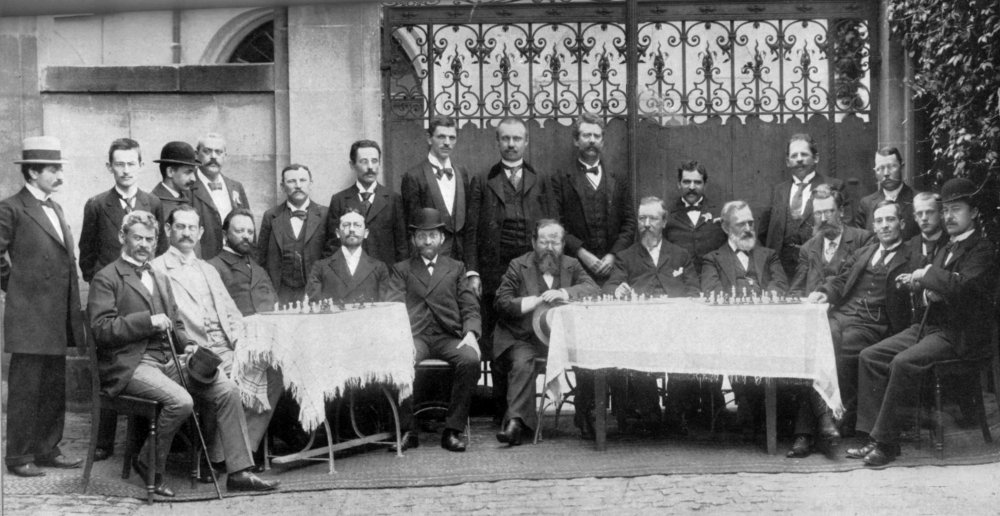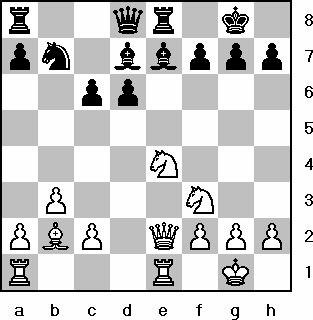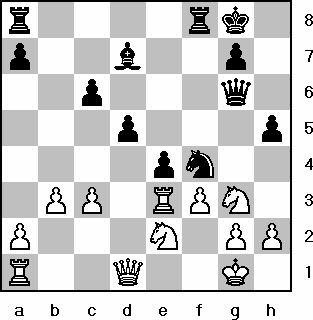|
|
|
Moritz Porges ( 1859 - 1909) Chess Player
|
| Moritz Porges (b. 23/3/1857, d. Prague 27/11/1909) was
a Czech chess player.
He belongs to the family tree of Natan Porges (Prague 1470)
His championship game against Emanuer Lasker (Nuremberg 20/07/1896)
is quoted in many chess anthologies.
https://www.geni.com/people/Moritz-Porges/6000000015120465983?through=6000000111188137821
MORITZ PORGES
(born Mar-22-1857, died Nov-27-1909, 52 years old) Austria |
|
Moritz Porges was considered one of the most promising chess talents from Bohemia.
He started to play chess at the age of 13 and was also one of the strongest players of Vienna and Prague, where he spent the last 25 years of his life.(1)
At Dresden (1892), Porges shared second place with Gyula Makovetz ahead of Simon Winawer, James Mason and Joseph Henry Blackburne .(2)
Although Porges did not fulfill the high expectations at Nuremberg (1896), he scored wins over Richard Teichmann and Blackburne. Additionally, he remained undefeated against Siegbert Tarrasch, Harry Nelson Pillsbury and Carl Schlechter. During the tournament, he suffered from gastroenteritis.(1)
Afterwards, Porges did not return to international chess scene, concentrating on his private life instead.
He died in 1909 at Prague, at the age of 52, from a medical condition which he had been suffering from for years.(1)
Sources
(1) Pages 48-49 of the February 1911 'Wiener Schachzeitung'. Provided in "ANNO / Österreichische Nationalbibliothek"
(2) Rod Edwards. http://www.edochess.ca/tournaments/... |
Source : http://www.chessgames.com/perl/chessplayer?pid=10484
|
|
NÜRNBERG 1896
Nürnberg 1896 should have become a German Chess Congress,
but the local chess club took over the organisation and included
no minor groups.
Thirty-nine players wanted to participate
in the master competition, nineteen were allowed.
When Burn
withdrew, Charousek took his place.
The contest coincided
with the Bayerischen Landesausstellung.
Nineteen rounds were played in the premises of the Museum
Society from 20 vii until 9 viii.
A tempo of thirty moves
in two hours was applied in the morning.
Games were resumed
in the afternoon with a time limit of fifteen moves per hour
and continued until the end.
The main prizes went to Lasker
(3000 M), Maróczy (2000 M), Tarrasch and Pillsbury
(each 1250 M), Janowsky (600 M), Steinitz (300 M), Walbrodt
and Schlechter (each 100 M).
The level and rules were similar
to Hastings 1895.

Standing: Lasker, Charousek, Schlechter, two organisers, Janowsky,
Maróczy, Marco, Showalter, three organisers
Seated: Albin, Porges, Chigorin, Tarrasch,
Winawer, Steinitz, Blackburne, Schallopp, Schiffers, Pillsbury,
Walbrodt, Teichmann
Lasker had a better result than in Hastings, because he won
by one point instead of trailing the winner by the same margin.
The world champion was on his way to complete superiority
in super tournaments.
Tarrasch regarded five games won by
Lasker as ‘lucky’.
An important example was Lasker
- Chigorin. Tarrasch underestimated the importance of tactics.
Later Lasker was characterised as a ‘psychologist’,
who made errors in order to confuse the opponent.
That was
even more naive.
|
His championship
records :
Number of games in database: 18
Years covered: 1892 to 1896
Overall record: +4 -9 =5 (36.1%)*
http://www.chessgames.com/player/moritz_porges.html |
The
Porges Lasker game (Nuremberg 20/07/1896)
Last time we discussed how to
build an attack. You will recall that an important attacking
element is the threat. By stringing threats together on each
successive move, you’ll be able to add more and more
pressure until something snaps. You’ll break through
and earn a well-deserved victory.
Alertness is all-important. If you don’t seize the opportunity
it will likely vanish forever. And, your opponent may build
an attack with threats of her own. I highly recommend going
over master games — especially games from long ago —
to learn how the master’s sharp play brings marvelous
victories.
The following game was played over 100 years ago between M.
Porges and world champion Emanuel Lasker (with black). Lasker
loved to catch his napping opponents with a surprise attacks.
Let’s see how he does it.
1. e4 e5
2.Nf3 Nc6
3. Bb5 Nf6
4. 0-0 Nxe4
5. d4 Be7
6. Qe2 Nd6
7. Bxc6 bxc6
8. dxe5 Nb7
9. b3 0-0
10. Bb2 d5!
11. exd6 e.p. cxd6
12. Nbd2 Re8
13. Rfe1 Bd7
14. Ne4?

Black to move
White sees no danger. After all, black’s pieces are
not even past the second rank. But watch how Lasker plays
sharply. By using a threat with every move he totally transforms
the position.
14 … d5 (the first on many threats)
15. Ned2 The knight must retreat because 15. Ng3 Bb4 wins
the exchange.
15. … Ba3
This powerful discovery produces two threats and limits white’s
choice to a single move.
16. Be5 f6 (Notice how sometimes the threat is a very simple
move. Simple, but effective.)
17. Qa6
Unable to respond directly to Lasker’s latest threat,
white creates threats of his own.
17. … fxe5
18. Qxa3 e4
White has avoided losing material. However, the threats keep
coming. And, compare Lasker’s pawns now to how they
looked in the previous diagram. What an improvement!
19. Nd4 Qf6!
Yes! Lasker gains time yet again and prepares to launch a
kingside attack.
20. c3 Rf8
Having completed his work in the e-file, the rook teams up
with the queen on the f-file.
21. f3
White would prefer not to loosen up his kingside like this.
But, what else can he do? On 21. Rf1 Qg5 followed by 22. …
Bh3 wins the exchange. Or the unnatural 21. Re2 is met by
c5 22. Nc2 Bg4 (or 22. … Qxc3 first).21. … Qg5
(Never letting up on those threats) 22. Qc1 Nc5!
Now it’s the knight’s turn to get into the act.
There’s now a strong threat of winning the exchange
with 23. … Nd3.
23. Nf1 Qg6
Lasker avoids the queen trade and simply repeats the threat
of 24. … Nd3. Also, 24. … exf3 is threatened as
well. It’s a common mistake among juniors to trade queens
too readily. As you can see, Lasker’s queen is important
to the attack.
24. Re3 Nd3With each move Lasker improves the position and
coordination of his pieces. On the other hand, white’s
pieces look like they’ve been tossed in a blender.
25. Qd1 Nf4
26. Ng3 h5!The white knight won’t be able to stay on
g3.
27. Nde2

Black to move
Desperate to remove the black knight, white temporarily weakens
his f3 square. Lasker knows that strong positions often enable
winning sacrifices. Ever on the alert for the opportunity,
he uncovers a very nice "sac" which breaks open
the kingside.
27. … Nxg2!
Now the king reluctantly takes a walk.
28. Kxg2 exf3+
29. Rxf3 Bh3+!
30. Kxh3
30 Kf2 holds out longer. But after 30. … Bg4! Lasker’s
attack rages ahead and soon he’ll play h4 to dislodge
the knight on g3. This is a fun position to test your analyzing
ability.
30. … Qg4+!
31. Kg2 Qxf3+
32. Kg1 h4
33. Nh1Or, you might prefer to end it with
33. Nf1 h3 followed by 34. … Qg2 mate.
33. … Qe3+ Resigns For
34. Kg2 allows the black h-pawn to do the honors.
Being sharp is a lot more fun than being dull. You can learn
how to be sharp by going over games of the chess masters from
long ago. May you too enjoy the thrill of sharp play.
|
Moritz Porges vs
Wilfried Paulsen
DSB-07.Kongress 1892 · Sicilian, Kan (B42)
· 1-0
http://www.chessgames.com/perl/chessgame?gid=1265871
|

Moritz
Porges
(b. 23/3/1857, d. 27/11/1909)
Friede seiner asche! |
J.U. Dor :
Josef Porges
(b. 1847, d. 3/7/1890 at 43 yo)
Ruhe sanft im Schoss der Erde
Du geliebter, guter sohn
Deine fromme Seele werde
Seliger vor Gottes Thron |
Plots 1-2-1 & 1b
This grave is the oldest Porges stone in the cemetery.
Photo : 1993
http://www.porges.net/PorgesGravesNJC.html |
|
|